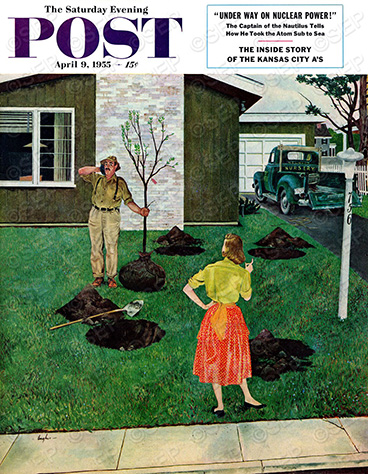There is an anonymous saying that goes: “The best time to plant a tree was 20 years ago. The second best time is now.” Since National Arbor Day is coming up fast, you might as well start the process by choosing and planting a tree of your choice before summer heat makes tree planting impractical.
Planting in cool weather gives a tree’s roots time to establish before rain and sun force their energy instead into making top leaves.
When you purchase a tree at a nursery, its roots will have been trimmed by 90 percent or more and confined in burlap or a plastic bucket. All trees that have been dug up and prepared for transplanting are suffering from transplant shock, meaning they will be slow growing for a time until they recover. By taking care when you plant a tree, you can help it overcome the shock and start growing faster.
Dig a hole for the tree that is wide and shallow and no deeper than the root ball. The wideness allows roots to push into the surrounding soil. Most of the roots from a newly planted tree will go into the top 12 inches of soil.
Make sure the soil under the tree is firm. Don’t dig and backfill before placing the roots, or the tree may gradually sink down.
The trunk flare at the base of the tree should just break the soil after planting.
Stand back from the tree and adjust it to make sure it is vertical before you begin backfilling. Best of all have your spouse view the tree from several directions while you are planting. Then if it goes in crooked it won’t be your fault, and you won’t have to hear about it until the end of time.
Remove the burlap from the root ball. Some nurseries use synthetic burlap that will not decay. Even genuine burlap may take up moisture from the soil depriving the tree of the water it needs to recover quickly from transplant shock.
If you are planting in heavy clay soil, leave the top third of the root ball above the backfill and fill the rest with good soil and cover with mulch. This will help get roots from languishing in soggy, moisture soaked clay.
Begin fertilizing a tree once a year, one year after it has been planted. Apply a time release or an organic fertilizer which helps release soil minerals under the tree and up to three feet beyond the tree’s branches. Drilling holes in the soil will help the fertilizer reach the roots. Be sure to water thoroughly after applying fertilizer.
Decorative Tree Choices
If you want to make your neighbor’s sit up and take notice of your landscaping skills, here is a short list of trees that are likely to have them coming around to ask, “What’s that?”
Full Moon Maple
A small size Japanese maple has wide leaves which are a brilliant lime green in spring and turn an amazing array of bright colors in fall.
Japanese Sunrise
Another small maple which has branches that remind one of both yellow and red dogwood branches in winter, but without the nasty aptitude for spreading.
Paper Bark Maple
A large growing maple (20 to 30 feet) with exfoliating bark in hues from cinnamon to reddish brown and purplish older bark, a remarkable combination of color and interest.
Variegated Ginko
Unlike typical ginko trees, these have the additional interest of green and white striped leaves.
Become a Saturday Evening Post member and enjoy unlimited access. Subscribe now



